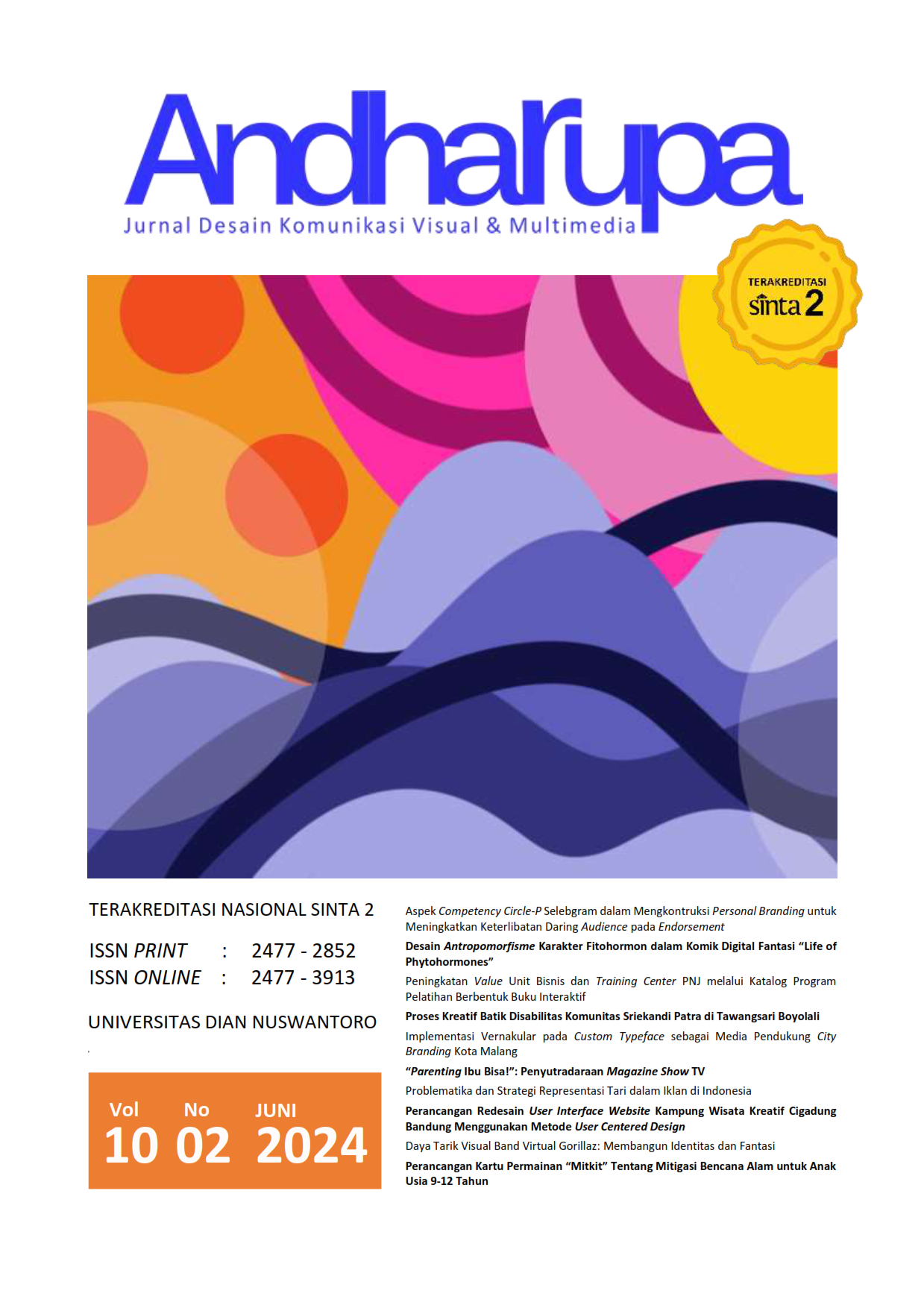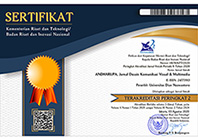“PARENTING IBU BISA!” : PENYUTRADARAAN MAGAZINE SHOW TV
DOI:
https://doi.org/10.33633/andharupa.v10i02.8712Keywords:
penyutradaraan, televisi, magazine show, parenting, penelitian artistikAbstract
Abstrak Fenomena ibu-ibu muda yang membutuhkan panduan dalam mengasuh anak menjadi tema penting untuk diangkat dalam program televisi. Penelitian artistik ini bertujuan untuk mendeskripsikan bagaimana program magazine show dirancang dan disutradarai dengan topik parenting. Penciptaan program ini dengan konsep penyutradaraan what people want and need to see dan dikreasi menggunakan SOP produksi televisi yaitu praproduksi, produksi, dan pascaproduksi. Penelitian artistik ini menghasilkan sebuah program acara magazine show berjudul Ibu Bisa! episode Sabtu Bersama Ibu dengan topik parenting yang terdiri atas enam rubrik dan disajikan dalam empat segmen. Program Ibu Bisa! berhasil diproduksi melalui pemilihan topik yang tepat, penentuan narasumber berkompenten, dan penerapan konsep visual (warna, animasi, supers text) yang dikemas sebagai kesatuan bentuk (form) dan isi (content). Sehingga, program ini dapat menjadi tayangan menarik dan memberikan nilai tambah bagi penonton ibu-ibu muda dalam memahami dan mengaplikasikan parenting. Kata Kunci: Penyutradaraan, televisi, magazine show, parenting , penelitian artistik Abstract The phenomenon of young mothers preparing to raise children becomes an interesting theme to be presented in television programs. This artistic research aims to describe how magazine show programs are designed and directed with the topic of parenting. The creation of this program uses the concept of directing “what people want and need to see” and is created using television production SOPs, namely pre-production, production and post-production. This artistic research resulted in a magazine show program titled Ibu Bisa! the ‘Saturday with Mother’ (Sabtu Bersama Ibu) episode with the topic of parenting which consists of six rubrics and is presented in four segments. Ibu Bisa! program successfully produced through selecting the right topic, determining competent sources, and applying visual concepts (colors, animations, supers text) which is packaged as a unified form and content. So, that this program can become an interesting show and provide added value for viewers of young mothers in understanding and applying parenting. Keywords: directing, television, magazine show, parentingReferences
Afrilia, A. M. (2017). Penggunaan New Media di Kalangan Ibu Muda sebagai Media Parenting Masa Kini. Jurnal Komunikasi dan Kajian Media, 1(1), 31–42.
Bignell, Jonathan & Woods, Faye. (2023) An Introduction to Television Studies. 4th Edition. London: Routledge.
CAP. (n.d.). Use of Superimposed Text in Television Advertising: Advertising Guidance (Broadcast). London: The Committee of Advertising Practice (CAP).
Collie, C. (2012). The Business of TV Production. Cambridge University Press.
Datacolor. (2020). Create Your Dream Nursery with ColorReader EZ. (2020, October 2). Datacolor-ColorReader. https://www.datacolor.com/colorreader/blog/create-your-dream-nursery-with-colorreader-ez/
Feldman, R. (2015). The Adaptive Human Parental Brain: Implications for Children’s Social Development. Trends in Neurosciences, 38(6), 387–399.
Huda, A. (2019). Cara Mudah Belajar Desain Grafis (Corel Draw, Photoshop dan Sablon Digital). UNP PRESS.
Novliadi, F., Safrin, Ramadhani E. (2023). Membangun Komunikasi Orang Tua Dan Anak Melalui Program Parenting Di TK Ar-Rahman, Desa Tadukan Raga, Kecamatan STM Hilir, Deli Serdang. KomunikA Jurnal Ilmu Komunikasi, Vol. 19 No. 01.
Pangestu, Ravik Dwi. (2019). Penyutradaraan Magazine D’Tail Episode Wedangan Pendopo dengan Komposisi Split Screen. ISI Surakarta
Putra, R. W. (2021). Pengantar Desain Komunikasi Visual dalam Penerapan. Penerbit Andi.
Prayudhani, Oktaviana. (2019). Kemampuan Kognitif-Nonkognitif dan Labor Market Outcomes: Studi Empiris Menggunakan Data IFLS 2014. Jurnal Ketenagakerjaan, 14 (2), 98 - 111
Santrock, J. W. (2020). Child Development: An Introduction 15th Edition. McGraw-Hill Education.
Supriyono, A., Idrus, S. I., Buana, I. C., Sihombing, I. N., Noviar, M. H. (2019). Modul Presentasi dengan Infografis. Bidang Perencanaan Diklat DPR RI.
Syuhudi, M. I. (2022), Berbagi Kuasa: Kesetaraan Peran Suami Istri dalam Rumah Tangga. Mimikri; Jurnal Agama dan Kebudayaan, 8(1), 207 – 229.
Wicaksono, Bagas Radityo., Agustrijanto. (2022). Evaluasi Produksi Video UMKM Jasijuka di Facebook. Jurnal Mahasiswa Institut Teknologi dan Bisnis Kalbis, 8(2), 2216 - 2227
Wijaya, Erris; Rahmanto, Andre & Muhammad, Albert. (2022). Preferensi Media Para Millenial terhadap Televisi Konvensional (Free To Air) dan Layanan Video Berlangganan (Over The Top). ANDHARUPA: Jurnal Desain Komunikasi Visual & Multimedia, Vol.08 No.04, p. 447- 465
Downloads
Published
Issue
Section
License
Copyright (c) 2024 ANDHARUPA: Jurnal Desain Komunikasi Visual & Multimedia

This work is licensed under a Creative Commons Attribution 4.0 International License.
Authors who publish with this journal agree to the following terms:
- Authors retain copyright and grant the journal right of first publication with the work simultaneously licensed under a Creative Commons Attribution License that allows others to share the work with an acknowledgment of the work's authorship and initial publication in this journal.
- Authors are able to enter into separate, additional contractual arrangements for the non-exclusive distribution of the journal's published version of the work (e.g., post it to an institutional repository or publish it in a book), with an acknowledgment of its initial publication in this journal.
- Authors are permitted and encouraged to post their work online (e.g., in institutional repositories or on their website) prior to and during the submission process, as it can lead to productive exchanges, as well as earlier and greater citation of published work (See The Effect of Open Access).















